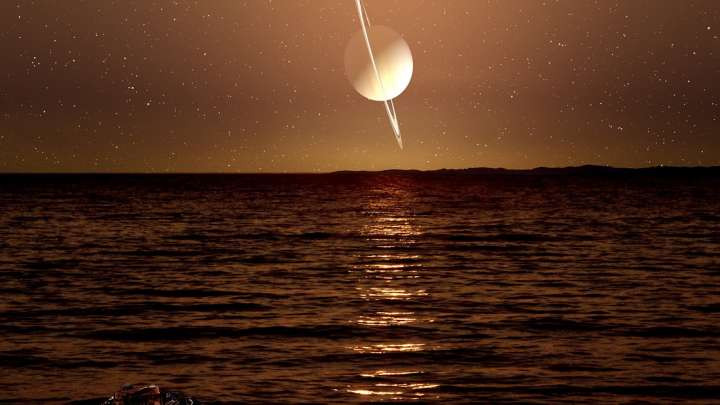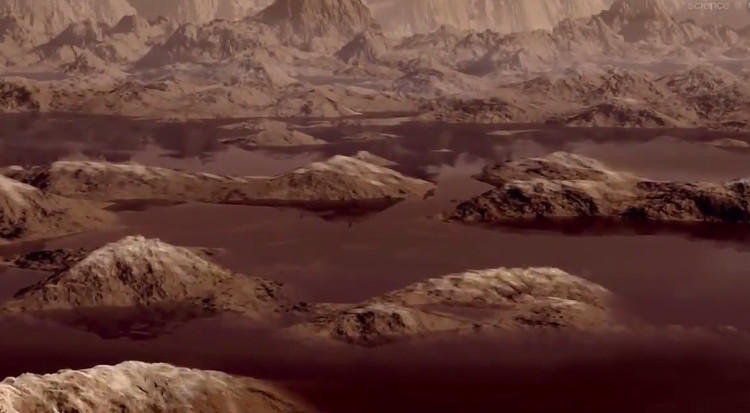Saturn's moon wave is only 1 centimeter tall
Earth is not the only place with sea and lake. Somewhere on Saturn and the unknown planets, there is still a tide. Surprisingly, on Saturn, the waves are so unbelievably low.
1 centimeter high wave, how deep is the lake?
Saturn's Titan moon is the only place outside of Earth known for its liquid-filled surface. A recent study has given us a surprising view of the oceans and rivers and lakes in our world, with small waves swirling around.
This study was published in the journal Earth and Articles on Planetary Science. Researchers led by the University of Texas found that the waves on Titan reached only about 1 centimeter high. They can also rise to a height of 20 centimeters.

The waves on Saturn's moon are very low.(Photo: Space).
This amazing thing was discovered by radar data from the Cassini spacecraft. Cyril Grima, the lead author of the study, developed a technique that could measure "surface roughness" in great detail. The device can measure waves with a height of not more than 1.5 to 2.5 cm. Grima said in the newspaper: the wind speed here is estimated at 0.22 meters per second at a height of 10 meters above the surface.
The researchers surveyed three lakes on the Titan's northern hemisphere: Kraken Mare (Titan's largest lake), Ligeia Mare and Punga Mare . Cassini's last flight on Titan this April aims to study the area carefully. Data from the Cassini spacecraft may soon tell us how deep these lakes are.
This study helps scientists know that wind on Titan has a low speed. This means that if we want to place a probe in one of the seas - previously studied - the wind may not cause too many problems. Currently, Titan's wind speed is low and the moon is in "summer" condition. This makes people suspect that summer is the most windy season on Titan.

The array of liquid on Titan is not the same as on Earth.
1,000 years of rain once
Grima said: "One day when we send the probe to the lakes, that day will be a very interesting day. And when this is done, you will want to have a safe, wind-free area. "Our research shows that because the waves are not high, the wind is relatively low."
The array of liquid on Titan is not the same as on Earth. While the liquid on our planet is made of water, on Titan they are liquid hydrocarbons, this is the basic ingredient for jet fuel. Like on Earth, these fluids undergo a cycle of evaporation and rain, although each location on Titan sees only about 1,000 years of rain.
In 2005, researchers sent the first probe to Titan: ESA's Huygens probe. This ship showed a wonderful image of the ground, and since then our 'craving' of Titan has been met even more. NASA is harboring the idea of sending a probe like a ship to Titan, which can be done at some point in the future Titan.

The wind on Titan has a low speed.
The 'tiny' height of waves on Titan has actually been studied before, but all of this evidence is only theoretical. The waves here move at 0.7 meters per second, and are probably too slow (and low) for people to surf. But at least we can ship it.
There are still many unknown things about Titan, Grima noted. But this study at least tells us more about what is existing on Titan and certain types of climate.
" Titan's wind season may begin later than expected in summer, but it may also be the season that changes with time or space. We cannot set the rules for small, unstable waves. "In a long time like this. Future studies on climate models will be responsible for considering whether these hypotheses are correct ," a researcher said.
- China decided to conquer Ms. Hang
- Does the Moon have its own moon? And you will be surprised with its name!
- Wi-Fi waves are not harmful to health
- The man 'both tall and tall' is unique in medical history
- What is super moon? When will Vietnam receive Super Moon?
- Interesting things few people know about the Moon
- Production of electric wave under the wave under the sea
- New NASA research: Water and humans can be found on the Moon, so come back soon
- Official: Americans will return to the Moon
- At the time of dinosaurs, volcanoes on the Moon used to work?
- Why is the Mid-Autumn Moon bigger and redder?
- The scene of an alien spaceship drying up on the Moon
 Van Allen's belt and evidence that the Apollo 11 mission to the Moon was myth
Van Allen's belt and evidence that the Apollo 11 mission to the Moon was myth The levels of civilization in the universe (Kardashev scale)
The levels of civilization in the universe (Kardashev scale) Today Mars, the sun and the Earth are aligned
Today Mars, the sun and the Earth are aligned The Amazon owner announced a secret plan to build a space base for thousands of people
The Amazon owner announced a secret plan to build a space base for thousands of people